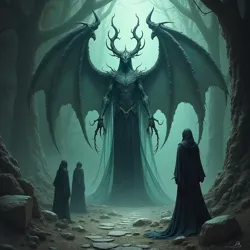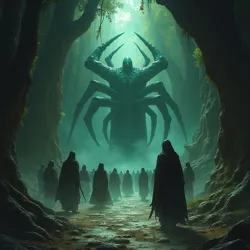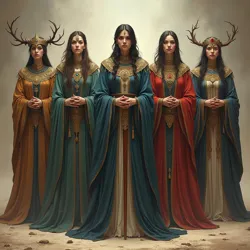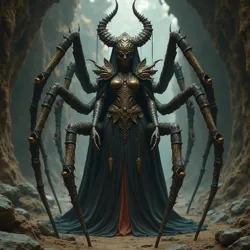Teir'dal Ascendancy

Depicts the Teir'dal Ascendancy, also known as Drow Society, a complex and influential civilization in the Underdark, characterized by their matriarchal hierarchy and devotion to the Spider Queen.
Drow Society
Shadow Kin
Matriarchal Hierarchy
Spider Queen Pantheon
Underdark
ancient elven schism
The *Teir'dal Ascendancy*, an archaic designation for what is more commonly known as Drow Society, represents a civilization of formidable complexity and enduring influence within the Underdark. This term, "Teir'dal," rooted in the ancient elven tongue, translates roughly to "Shadow Kin" or "Children of the Twilight," reflecting both their ancestral lineage and their adaptation to the sunless depths. The Ascendancy is characterized by a rigid Matriarchal Hierarchy, a profound devotion to a pantheon of deities led by the enigmatic Spider Queen, and a culture steeped in arcane arts, martial prowess, and intricate social stratagems. Their society, forged in the crucible of subterranean existence, stands as a testament to resilience, cunning, and an unwavering commitment to their unique cultural and religious tenets.
Origins in Shadow: The Great Schism
The genesis of the Teir'dal Ascendancy is inextricably linked to a cataclysmic schism within the ancient elven civilization of the surface world. Millennia ago, long before the establishment of human empires or the rise of dwarven strongholds in the mountains, the elves were a unified race, dwelling in arboreal cities and venerating a diverse pantheon of nature deities. However, ideological fissures began to emerge, primarily centered around differing interpretations of arcane philosophy and the very nature of elven destiny. This divergence culminated in a bitter and protracted civil conflict known in elven chronicles as the Sundering, a period of internecine warfare that fractured elven society irrevocably.
 Shows the origins of the Teir'dal from a schism in ancient elven society, leading to their exile and descent into the Underdark.
Shows the origins of the Teir'dal from a schism in ancient elven society, leading to their exile and descent into the Underdark.One faction, led by a charismatic and powerful elven noblewoman who would later become revered as the Spider Queen, advocated for a radical departure from traditional elven values. They espoused a philosophy emphasizing personal ambition, ruthless pragmatism, and the pursuit of power through any means necessary. This group, disillusioned with what they perceived as the decadence and stagnation of surface elven culture, sought a new path, one that embraced the shadows and harnessed the untapped potential of the subterranean realms. Driven from their ancestral lands by their ideological opponents, these dissenting elves embarked on a perilous exodus, descending into the labyrinthine depths of the Underdark. This migration, a voluntary exile into perpetual twilight, marked the true birth of the Teir'dal, severing their ties to their surface kin and setting them on a trajectory towards their unique destiny.
Adaptation and Subterranean Forging
Upon entering the Underdark, the exiled elves faced an environment of unrelenting hostility and profound darkness. They were compelled to adapt rapidly to survive in a world devoid of sunlight, teeming with monstrous creatures, and characterized by scarce resources. This period of adaptation was transformative, forging the Teir'dal into the resilient and formidable civilization they would become. Their physical forms underwent subtle but significant changes over generations, their skin darkening to obsidian hues, their eyes becoming larger and more sensitive to low-light conditions, and their bodies becoming leaner and more agile. These physiological adaptations were not merely cosmetic; they were crucial for survival in the dimly lit caverns and tunnels of their new home.
Culturally, the Teir'dal underwent an even more profound metamorphosis. Their ancestral reverence for nature deities waned, replaced by a fervent devotion to the Spider Queen, who became the central figure of their new pantheon. Her teachings, emphasizing cunning, ambition, and the ruthless pursuit of dominance, became the guiding principles of Teir'dal society. The rigid matriarchal structure that characterizes their civilization emerged during this period, perhaps as a pragmatic response to the challenges of survival in a harsh environment, or as a reflection of the Spider Queen's own divine authority. Noble Houses, each vying for power and prestige, arose as the fundamental units of Teir'dal social organization, mirroring the intricate web-like structures venerated in their religion. The Underdark, initially a refuge from persecution, became the crucible in which the Teir'dal Ascendancy was forged, transforming exiled elves into a distinct and formidable subterranean civilization.
The Matriarchal Dominion: Weaving the Web of Power
The defining characteristic of the Teir'dal Ascendancy is its unwavering commitment to a matriarchal social structure. Unlike many surface societies where patriarchal norms prevail, Teir'dal culture unequivocally places females at the apex of power and authority in all spheres of life. This matriarchal dominion is not merely a social custom; it is deeply ingrained in their religious dogma, perceived as divinely ordained by the Spider Queen and fundamental to the very fabric of their civilization. From religious leadership and noble governance to military command and arcane scholarship, females hold positions of preeminence, their decisions shaping the destiny of their houses, cities, and the Ascendancy as a whole.
 Illustrates the matriarchal structure of Teir'dal society, where females hold positions of power in religion, governance, and military, shaping their civilization.
Illustrates the matriarchal structure of Teir'dal society, where females hold positions of power in religion, governance, and military, shaping their civilization.Males within Teir'dal society occupy a subservient, though not insignificant, role. Their primary functions are typically relegated to martial pursuits, artisan crafts, and serving the dictates of their female superiors. While males can achieve positions of influence, particularly in specialized fields such as warfare or certain branches of magic, ultimate authority always remains vested in the matriarchs. This gendered hierarchy is rigorously enforced, with social norms and religious sanctions reinforcing female dominance and male subordination. However, it is crucial to understand that this is not simply a system of female oppression. Teir'dal matriarchy is a complex and nuanced structure, deeply intertwined with their cultural values and religious beliefs, shaping their society in profound and multifaceted ways.
Noble Houses: The Pillars of Power
Teir'dal society is organized into a complex network of noble houses, each vying for dominance and influence within their respective city-states and across the broader Underdark. These houses are not merely familial units; they are powerful political entities, controlling territories, resources, and legions of warriors and arcane practitioners. Lineage is of paramount importance, with noble status and inheritance passing exclusively through the female line. The matriarch of a house holds absolute authority, making decisions on matters of politics, economics, and familial affairs. These matriarchs, often formidable sorceresses and cunning strategists, engage in intricate power plays, forging alliances, and orchestrating rivalries with other houses, creating a dynamic and often volatile political landscape.
The noble houses are arranged in a strict hierarchy, with a select few dominant houses wielding the majority of power and prestige, while lesser houses struggle for survival and advancement. Social mobility is exceedingly rare, and ascension to a higher rank is typically achieved through strategic marriages, political machinations, or exceptional displays of favor from the Spider Queen. The names of these houses, often evocative of their ancestral origins, patron deities, or defining characteristics – such as House Vilewhisper and House Shadowsilk, prominent in tales like the Pheromone Philtres of Claus Jabbers cycle – contribute to the rich tapestry of Teir'dal aristocratic culture. Intra-house rivalries and inter-house conflicts are endemic to Teir'dal society, fueling a constant struggle for power and dominance that shapes their political and social dynamics.
Class Structure and Servitude
Beyond the intricate web of noble houses, Teir'dal society encompasses a rigid class structure that dictates the roles and opportunities available to individuals based on their birth, gender, and perceived favor of the Spider Queen. Below the nobility are the common Teir'dal, who form the backbone of society, fulfilling roles as warriors, artisans, merchants, and laborers. Even within the common classes, distinctions exist based on skill, profession, and religious piety. Warriors, particularly those adept in the unique Teir'dal fighting styles and weaponry, hold a relatively elevated position, as do master artisans and skilled arcane practitioners outside of the noble houses.
At the nadir of Teir'dal social hierarchy reside the slaves, predominantly captured from other Underdark races or surface incursions. Slavery is deeply entrenched in their culture, considered essential to their economy and social order. Slaves perform menial tasks, heavy labor, and often serve as personal attendants to noble families. While slaves possess no rights and are subject to the capricious whims of their masters, some may, through exceptional service or specialized skills, attain positions of relative trust or even influence within a household, though they fundamentally remain chattel within the Teir'dal social framework. The treatment of slaves varies, but brutality and exploitation are commonplace, reflecting the harsh and unforgiving nature of Teir'dal society as a whole. This reliance on servitude underpins the Teir'dal economic and social structure, contributing to the stratified and often oppressive nature of their civilization.
Culture of Shadows: Religion, Art, and Values
Teir'dal culture is inextricably interwoven with their religious beliefs and the harsh realities of their subterranean existence. Their worldview is profoundly shaped by their devotion to the Spider Queen and her pantheon, deities who embody chaos, ambition, and the intricate web of fate. This religious doctrine permeates all facets of Teir'dal life, influencing their social norms, artistic expressions, ethical codes, and even their aesthetic sensibilities. The perpetual twilight of the Underdark, coupled with the tenets of their faith, has fostered a culture that is both darkly elegant and unsettlingly pragmatic, reflecting the unique environment and spiritual ethos of the Teir'dal Ascendancy.
 Represents the Teir'dal culture shaped by their devotion to the Spider Queen, influencing their art, values, and the aesthetics of their subterranean world.
Represents the Teir'dal culture shaped by their devotion to the Spider Queen, influencing their art, values, and the aesthetics of their subterranean world.The Spider Queen and Her Pantheon
The central figure in Teir'dal religion is the Spider Queen, whose true name is considered sacrosanct, rarely uttered even by her most devout priestesses. She is revered as the progenitor of the Teir'dal race and the ultimate font of their power and dominion. Her dogma emphasizes the virtues of ambition, cunning, and the relentless pursuit of power, often at the expense of others. Teir'dal society, in essence, is conceived as a terrestrial manifestation of her divine will, structured around hierarchies, intrigue, and the perpetual struggle for dominance. Priestesses of the Spider Queen wield immense authority, often rivaling or even surpassing the power of noble matriarchs. They serve as interpreters of divine will, conduct elaborate religious rituals, and exert considerable influence over political and social affairs, acting as the spiritual and often temporal arbiters of Teir'dal society.
Alongside the Spider Queen, a pantheon of lesser deities is also venerated, each representing different aspects of Teir'dal life and values. These deities may include figures associated with darkness, magic, warfare, and the Underdark itself, such as entities embodying stealth, venom, or subterranean flora and fauna. However, all are ultimately subservient to the Spider Queen, their worship often filtered through her dogma and interpreted by her priestesses. Religious festivals and ceremonies are frequent occurrences, often involving elaborate rituals, sacrifices, and ostentatious displays of devotion to the Spider Queen, reinforcing her central role in Teir'dal society and culture. These rituals often incorporate dramatic performances, intricate dances mimicking spider movements, and the recitation of sacred texts detailing the Spider Queen's mythology and commandments.
Aesthetics of the Abyss: Art and Architecture
Teir'dal aesthetics are characterized by a dark, elegant, and often unsettling beauty, reflecting their subterranean environment and the pervasive influence of the Spider Queen. Their architecture is renowned for its intricate stonework, seamlessly integrating naturally occurring cave formations and volcanic rock to create imposing and labyrinthine structures. Cities are frequently constructed within colossal caverns, illuminated by bioluminescent fungi and magically enhanced light sources, creating a perpetual twilight atmosphere that is both eerie and captivating. Spider and spiderweb motifs are ubiquitous in Teir'dal art and architecture, serving as constant visual reminders of their deity and their cultural identity. These motifs are not merely decorative; they are imbued with symbolic meaning, representing the interconnectedness of Teir'dal society and the intricate web of fate as envisioned by their religion.
Teir'dal art encompasses a diverse range of mediums, including sculpture, jewelry, weaving, and music. Sculptures are often meticulously carved from obsidian or other dark stones, depicting stylized figures of Teir'dal, spiders, and scenes from their mythology. Jewelry is crafted from precious metals and gemstones mined from the Underdark, frequently incorporating spider silk and intricate filigree work. Teir'dal music is typically somber and melancholic, utilizing stringed instruments crafted from cave flora and fauna and haunting vocal harmonies, reflecting the somber beauty of their subterranean world and the complex emotional landscape of their society. Their artistic expressions, while aesthetically distinct, often serve to reinforce their social hierarchy and religious beliefs, subtly promoting the core values of their culture and reinforcing the dominance of the Spider Queen's dogma.
Morality and Pragmatism: The Shadow Ethos
Teir'dal morality is fundamentally pragmatic and often perceived as ruthless by surface dwellers and even other Underdark races. Their ethical code prioritizes the advancement of oneself and one's house, often at the expense of others. Deceit, manipulation, and even assassination are not merely tolerated but frequently viewed as acceptable, even laudable, tools in the relentless pursuit of power and social advancement, particularly within the intricate and often treacherous rivalries of noble houses. Loyalty is primarily directed towards one's house and matriarch, and betrayal of these bonds is considered the ultimate transgression, punishable by severe sanctions.
However, within the seemingly amoral framework of Teir'dal society, a complex system of social norms and expectations exists. Etiquette and decorum are highly valued, particularly among the nobility, and meticulous adherence to these codes is essential for maintaining social standing and projecting an image of power and control. Duels and ritualized combat are common methods for resolving disputes and asserting dominance, providing a structured outlet for the inherent aggression and competitiveness of Teir'dal society. While outwardly appearing chaotic and treacherous to outsiders, Teir'dal society operates according to its own intricate and often unspoken set of rules and expectations, ensuring a degree of order within its complex and ruthlessly structured framework. This paradoxical blend of pragmatism and rigid social codes defines the unique moral landscape of the Teir'dal Ascendancy.
Subterranean Stratagems: Warfare and Tactics
The Teir'dal Ascendancy is renowned for its martial prowess and its mastery of subterranean warfare. Their military doctrines and fighting styles are uniquely adapted to the confined spaces, dim lighting, and treacherous terrain of the Underdark. Teir'dal warriors are trained from a young age in the arts of stealth, subterfuge, and close-quarters combat, emphasizing agility, precision, and the exploitation of environmental advantages. Their military organization, weaponry, and tactical approaches reflect the influence of their spider goddess and the harsh realities of their subterranean existence, making them formidable adversaries both within the Underdark and in incursions into the surface world.
Venom and Shadow: Teir'dal Armaments
Teir'dal weaponry is characterized by its lethality and its adaptation to subterranean combat. They are renowned for their mastery of poisoned blades, utilizing potent venoms derived from Underdark creatures and fungi to enhance the deadliness of their attacks. Lightweight armor, crafted from chitinous materials harvested from giant insects or magically treated leathers, provides protection without hindering agility in confined spaces. Spider silk, a material revered in their culture, is employed extensively in traps, nets, and even specialized weaponry, allowing them to ensnare and immobilize opponents. Their armaments are not merely tools of war; they are imbued with cultural and religious significance, reflecting their reverence for spiders and their adaptation to the Underdark environment.
Tactics of Subterfuge: The Art of Underdark Combat
Teir'dal military tactics emphasize stealth, subterfuge, and the exploitation of the Underdark's labyrinthine terrain. Ambush warfare, hit-and-run attacks, and the strategic use of tunnels and caverns are hallmarks of their combat doctrine. They excel in skirmishes and raids, utilizing their agility and knowledge of subterranean passages to outmaneuver and overwhelm their enemies. Massed formations are less common in Teir'dal warfare, replaced by smaller, highly mobile units that can navigate the complex Underdark environment with ease. Magic plays a crucial role in their military operations, with spellcasters providing support through illusions, enchantments, and offensive spells designed to disorient and incapacitate opponents in the dimly lit caverns. Their tactical approaches are not based on brute force but on cunning, precision, and the effective utilization of the Underdark's unique characteristics to their advantage.
Warrior Priestesses: Divine Combatants
A unique aspect of Teir'dal military culture is the prominent role of Warrior Priestesses. These female clerics, devoted to the Spider Queen and trained in both martial arts and divine magic, serve as elite combatants and spiritual leaders within Teir'dal armies. They are often deployed in the vanguard of assaults, inspiring their fellow warriors with their unwavering faith and formidable combat skills. Warrior priestesses wield potent divine magic, capable of healing allies, bolstering defenses, and unleashing devastating attacks upon their enemies. Their presence on the battlefield not only enhances Teir'dal military effectiveness but also reinforces the matriarchal nature of their society and the pervasive influence of religion in all aspects of their culture, including warfare.
The Teir'dal Cities: Subterranean Metropolises
Teir'dal cities are marvels of subterranean engineering and architectural ingenuity, carved into colossal caverns and labyrinthine tunnel networks deep within the Underdark. These metropolises are not merely settlements; they are centers of power, culture, and religious devotion, reflecting the unique character and societal structure of the Teir'dal Ascendancy. Illuminated by bioluminescent flora and magically enhanced light sources, these subterranean cities possess a unique and often unsettling beauty, a testament to Teir'dal adaptation and their mastery of their environment. Each city is typically ruled by a dominant noble house, reflecting the decentralized and often competitive nature of Teir'dal political organization. Teir'dal Cities are not merely functional urban centers; they are symbolic representations of Teir'dal power, resilience, and cultural identity within the vast and often hostile Underdark.
Architecture of the Abyss: Stone and Shadow
Teir'dal architecture is characterized by its seamless integration with the natural cave environment and its utilization of dark, locally sourced materials such as volcanic rock and obsidian. Buildings are often carved directly into the cavern walls, creating structures that appear to grow organically from the rock itself. Intricate stonework, featuring spiderweb motifs and stylized depictions of Underdark creatures, adorns facades and interiors, showcasing Teir'dal artistic skill and cultural symbolism. The use of bioluminescent fungi, cultivated in subterranean gardens and integrated into architectural designs, provides a soft, ethereal illumination that defines the visual character of Teir'dal cities. Magically enhanced light sources, often concealed within decorative elements, supplement the natural bioluminescence, creating a perpetual twilight atmosphere that is both eerie and captivating. Teir'dal architecture is not merely functional; it is an artistic expression of their culture, their environment, and their religious beliefs.
Notable Cities: Bastions of the Ascendancy
Across the Underdark, several Teir'dal cities stand out as particularly significant centers of power and influence. Menzoberran, perhaps the most renowned Teir'dal city, is a sprawling metropolis carved into a colossal cavern, known for its imposing architecture, its powerful noble houses, and its central role in Teir'dal politics and trade. Eryndlyn, another prominent city, is renowned for its arcane academies and its mastery of shadow magic, serving as a center of Teir'dal magical scholarship. Ched Nasad, a more militaristic city, is strategically located near key Underdark trade routes and is known for its formidable warriors and its dominance over surrounding territories. These cities, and numerous others scattered throughout the Underdark, represent the urban centers of the Teir'dal Ascendancy, each with its own unique character, history, and contributions to Teir'dal civilization as a whole.
Subterranean Infrastructure: Networks of Tunnels
Underpinning Teir'dal urban centers is a vast and intricate network of tunnels and passages that connect cities, resource locations, and strategic outposts throughout the Underdark. These subterranean roadways, often magically enhanced for speed and safety, facilitate trade, communication, and military movement across vast distances. The construction and maintenance of these tunnel networks is a monumental undertaking, requiring skilled engineers, laborers, and magical expertise. These networks are not merely utilitarian; they are symbolic of the interconnectedness of Teir'dal society and their mastery of the Underdark environment. The labyrinthine nature of these tunnel systems also serves as a defensive advantage, allowing Teir'dal forces to maneuver swiftly and surprise enemies who dare to invade their subterranean domain.